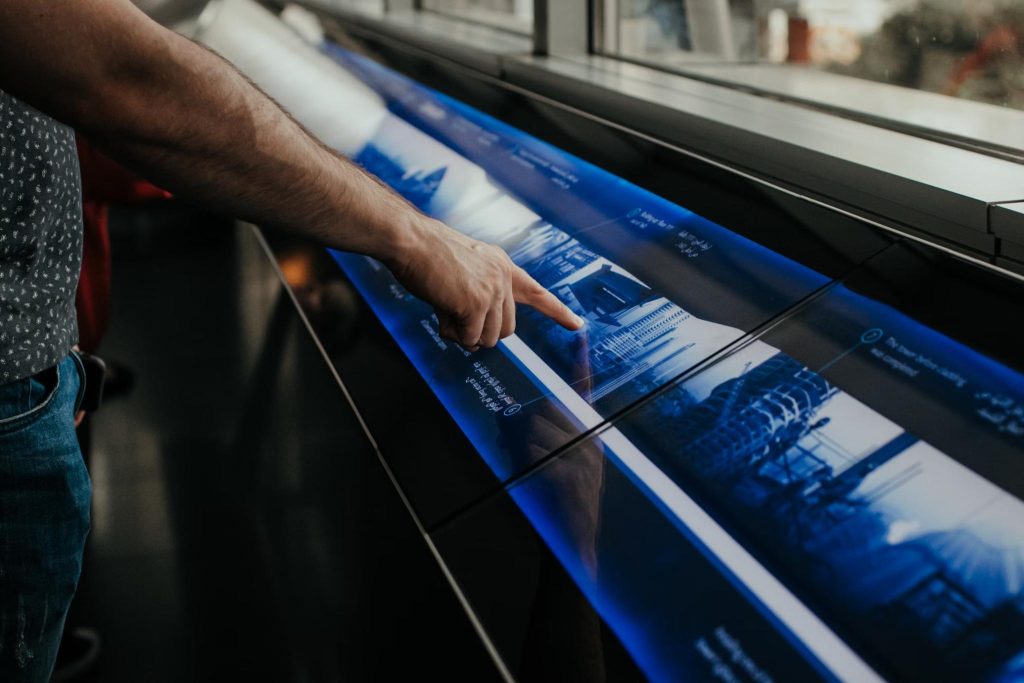Top 8 Types of Industrial Touch Screen Displays Available in 2023 (Part 2)
Industrial touch screens have become more common, from its early development in the 1960s until today, where it has become a standard in many applications.
This post is part two of the top eight types of industrial touch screens commonly used in various industries today (you can check out part 1 of the article here). Here, we discuss the remaining four industrial touchscreens, how they work, and where they are often used.
Let’s dive right in.
5. Optical Imaging Touch Screen
Optical Imaging touch screen is a touch-sensitive display technology that uses optical sensors to detect touch or input. It usually relies on these sensors placed around the screen’s edges—either in the bezel or the frame of the device—to capture the interruption in light patterns caused by touch.
The technology can also recognize and interpret various gestures and touch inputs in order to provide a more responsive and interactive user experience.
It’s like having a set of tiny cameras around the edges of the screen that “see” when and where you touch the screen so it can understand your commands (e.g. moving pictures, playing games, etc.) better.
Many optical imaging touch screens support multi-touch functionality which allows them to recognize and respond to multiple simultaneous touches or gestures. They are resistant to wear and tear and are versatile (they can be applied to displays of different sizes).
They also offer a hands-on and intuitive user interface which is why they are highly in demand for various applications such as interactive displays, kiosks, gaming machines, and information boards.
Note, however, that there are different types of optical touch technologies, and specific implementations may vary. The overarching principle involves using optical sensors to capture touch input, providing a responsive and interactive touch experience.
6. Acoustic Pulse Recognition (APR) Touch Screen
Acoustic Pulse Recognition (APR) touch screen uses sound waves or acoustic pulses to identify the location of touch on the screen. It usually consists of a glass or acrylic panel that has transducers—typically piezoelectric sensors—attached to its edges. These transducers emit acoustic waves across the surface of the screen.
When a user touches the screen, the touch disrupts the acoustic waves with the sensors detecting these disruptions. The system analyzes the time delay between the emitted pulse and the received signal to determine the precise location of the touch. This information is sent to the device’s controller so it can respond to the user’s input.
What are the characteristics of APR touchscreens? They are durable because they have no layers that can wear out. They also provide high levels of accuracy in touch detection and can support multi-touch gestures.
APR touch screens can often be seen in medical devices, manufacturing, industrial control systems, point-of-sale systems, military, and other industries where durability and accuracy are crucial.
7. 5-Wire Resistive Touch Screen
5-Wire Resistive touch screen is a specific type of resistive touch screen technology that incorporates a more robust and durable construction compared to 4-wire resistive touch screens.
Just like traditional wire resistive touch screens, a 5-wire resistive touch screen operates on the principle of detecting touch by measuring changes in electrical resistance. However, it has five layers instead of four: two outer layers of flexible, transparent conductive film (typically made of indium tin oxide) and three inner layers (X, Y, and center spaces layer).
Because each layer is dedicated to one specific axis of the touch screen, its accuracy and stability of touch detection are also enhanced. The design of a 5-Wire Resistive touch screen also contributes to its durability, longevity, and accuracy of touch detection.
Thus, they are suitable for applications that require precise touch input and where the screen might be subjected to frequent touch interactions. This includes industrial control panels, medical devices, point-of-sale (POS) systems, information boards, and similar environments.
8. Infrared (IR) Touch Screen
The choice between the traditional resistive and 5-wire resistive touch screen depends on the specific requirements of the application and the desired balance between cost and performance.
An infrared (IR) touch screen uses infrared light to detect and locate the touch points on the screen. It’s equipped with an array of infrared light-emitting diodes (LEDs) on one edge of the screen and infrared sensors or photodetectors on the other.
The infrared LEDs and sensors are arranged in an invisible grid pattern. When an object—such as a finger or stylus—touches the screen, it interrupts the infrared light grid. The interruption of the IR beams at specific points on the grid is detected by the sensors.
The system calculates the touch point’s coordinates or exact location based on the interruption in the grid before being sent to the operating system for interpretation and response to the touch input.
Infrared touch screens are durable because the surface is typically made of glass or other robust materials. They offer high touch resolution, allowing for accurate and precise touch input. And because it does not require a conductive overlay, IR touch screen also offers good image clarity and brightness.
IR touch screens can also support multi-touch gestures, enabling interactions with multiple points simultaneously. Thus, they are commonly used in public spaces and interactive applications such as interactive displays, kiosks, digital signage, and other similar systems.
Although it has many advantages, the IR touch screen has several drawbacks. Infrared touch screens can be affected by external light sources or contaminants on the screen’s surface. They can also be relatively expensive compared to some other touch technologies.
Find The Best Industrial Touch Screen Display Today
Are you looking for versatile and durable touch screen displays for industrial use? We can help.
IVS-Tech has been been helping clients from various industries grow their business by providing high-quality yet cost-effective touch screen displays—and we’ve been doing this for 11 years now and running.
Our experts can help tailor a solution that will fit your specific needs. For a hassle-free consultation, contact us today or visit our website for more information!






